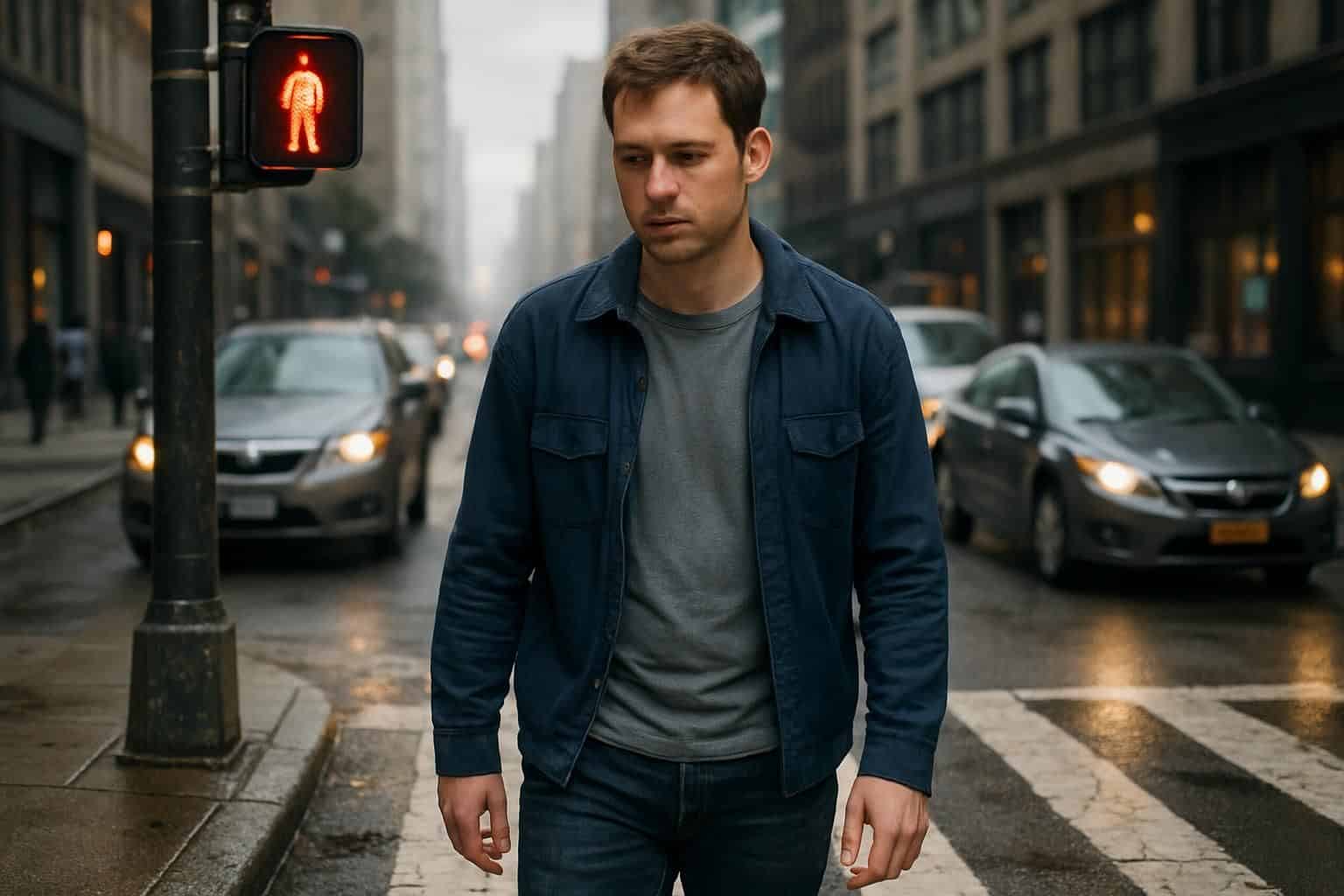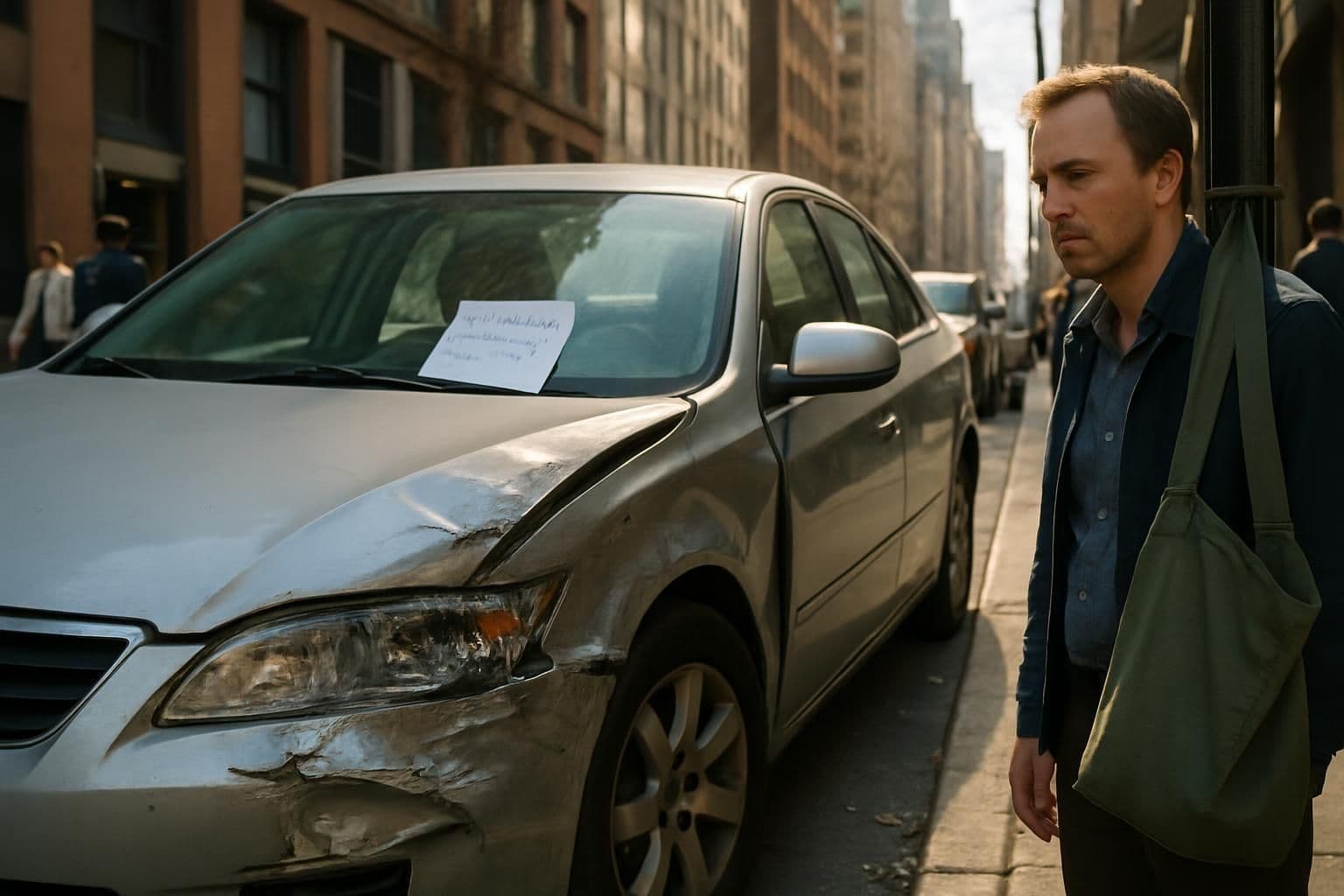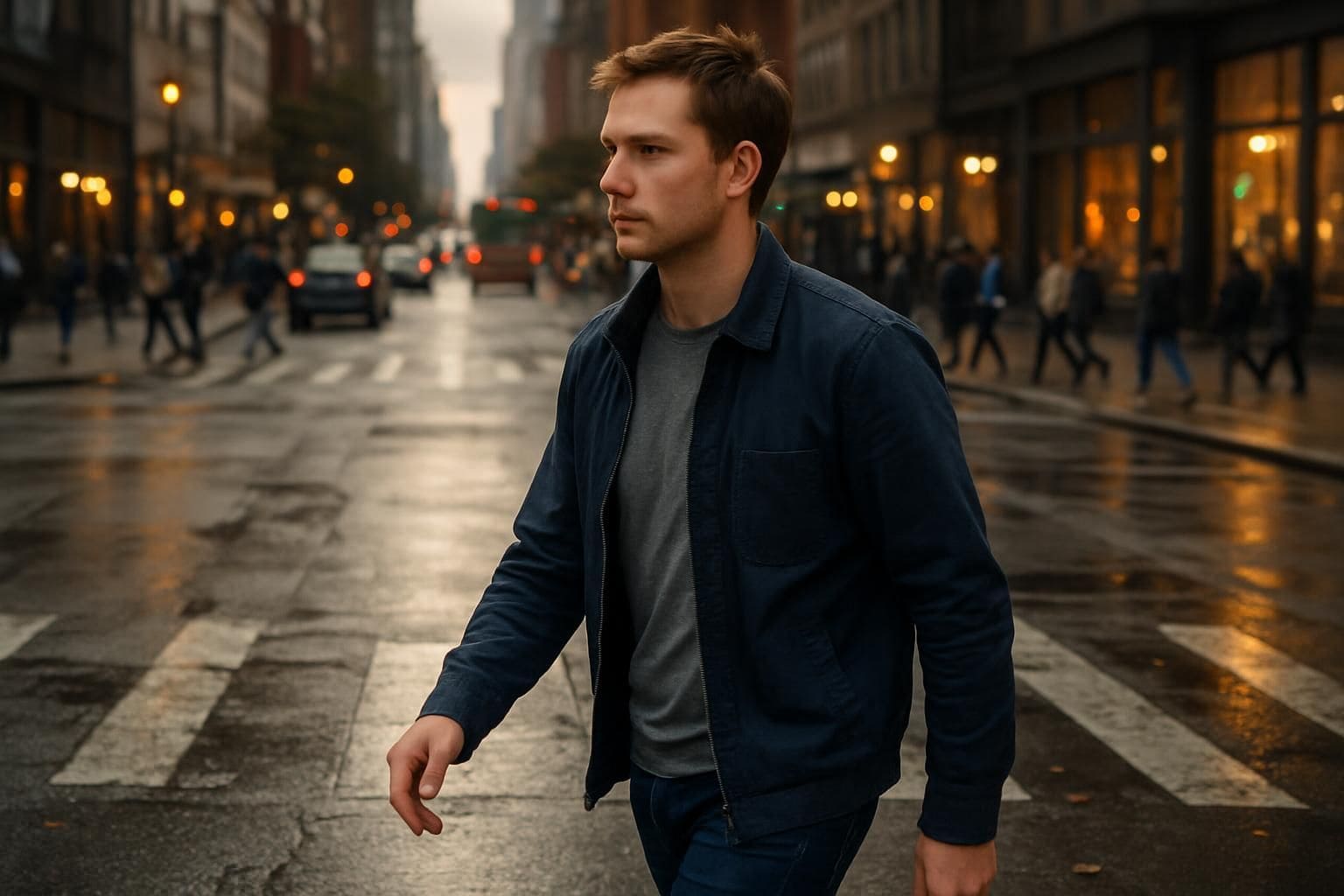Wondering what happens if a pedestrian caused an accident? While drivers usually get blamed, pedestrians breaking traffic laws can also be liable. This guide will clearly explain your legal rights and show you six steps to protect yourself after a pedestrian-caused accident.
Read on to avoid costly mistakes.
Key Takeaways
Pedestrians may be responsible for accidents if they jaywalk, disobey traffic signals, or step into restricted zones—like highways or construction areas.
To clearly prove a pedestrian caused the crash, you’ll typically need solid proof, including eyewitness accounts, official police reports, clear photos or video footage, and even testimony from accident experts.
Most states follow comparative negligence rules, splitting the blame between driver and pedestrian, which means your compensation gets lowered according to how much fault you’re assigned.
Drivers can often claim costs for repairing their cars, medical treatments, and any lost income resulting from pedestrian-caused accidents.
Possible ways to seek compensation include suing the pedestrian directly or filing a claim with your insurance company—but you’ll need to move quickly due to strict legal time limits.
Table of Contents
When Is a Pedestrian at Fault for an Accident?

Pedestrians can cause traffic accidents by breaking laws or acting carelessly on the road. A person on foot might be at fault if they step into traffic without warning or ignore basic safety rules.
Jaywalking or Crossing Outside a Crosswalk
Jaywalking can seriously endanger both drivers and walkers, especially on busy streets. According to GTW lawyers, if a collision happens while crossing the road outside marked spots, you might share some responsibility for the accident.
In California, you could even get a ticket for crossing unsafely, especially if it causes risks for cars or bicycles. Lots of people don’t know this, but crossing anywhere other than crosswalks can put some of the blame on you—even if drivers usually must yield.
I once watched a man run suddenly across a four-lane road, forcing a car to swerve sharply and crash into a parked vehicle. Later, the police report explained that both parties shared fault under comparative negligence laws.
The pedestrian ended up responsible for part of the medical expenses and car repair costs. Traffic regulations are there for a reason—to keep everyone safer—and using proper crossings is one easy way to prevent accidents.
The right of way isn’t an absolute shield; it comes with the duty to exercise reasonable care for your own safety and the safety of others on the road.
Ignoring Traffic Signals
Pedestrians who ignore traffic signals pose serious risks on roads. I once saw a man step directly into traffic, eyes glued to his phone—causing a startled driver to swerve and slam into a parked car.
Traffic laws clearly require pedestrians to obey walk signs, stoplights, and designated crossing signals. Many crashes occur because someone ignores a red light or crosses against a “Don’t Walk” sign.
Distractions like texting or alcohol consumption worsen the danger, making pedestrians less aware of nearby traffic.
In Wisconsin, comparative negligence rules impact how responsibility is divided. If a pedestrian causes a collision by ignoring traffic signals, authorities might assign them up to 70% of the blame.
That percentage significantly reduces how much compensation the pedestrian can receive. The driver has to show the pedestrian broke traffic laws to prove fault. Usually, this means demonstrating the signals were clearly visible and functioning properly at the incident’s time.
The next section covers how walking in restricted zones creates other dangerous scenarios—for both pedestrians and drivers alike.
Walking on Highways or Restricted Areas
Ignoring traffic lights is dangerous—but stepping into areas that ban foot traffic causes plenty of accidents too. Highways and restricted roads are off-limits to walkers, and with good reason.
Once, I spotted a man trying to dash across six busy lanes on I-95—and a car narrowly missed him by swerving, almost crashing into another vehicle.
Some people assume walkers automatically get priority on roads—but that isn’t necessarily accurate. If you stroll along highways or other prohibited spots, you might share the blame, or even fully carry it, if an accident happens.
Police reports will document your violation clearly, and your insurance company could reject your claim completely. Courts treat walking in restricted locations as a direct failure of your responsibility to be safe, significantly affecting fault determination and damages in personal injury lawsuits.
Proving Liability in a Pedestrian-Caused Accident

Proving fault in a pedestrian-caused accident needs solid facts and clear proof. Photos, videos, and witness reports can make or break your case in court.
Eyewitness Statements
Eyewitness accounts play a huge role in pedestrian-related accidents. Accurate testimony from people who saw it happen—such as if someone suddenly stepped into traffic or ignored crossing signals—can greatly clarify who’s at fault.
I once knew of a case where three different witnesses all confirmed the pedestrian was busy texting while stepping into a crosswalk against a red light. Their testimony clearly established the driver’s innocence, showing the accident was not your fault.
Reliable witness accounts can directly prove that a pedestrian broke traffic laws and help you build a convincing argument.
Effective eyewitness statements also provide helpful details about road conditions and visibility during the crash. They might mention whether it was rainy or dark—factors that can affect who is legally responsible.
Usually police get these statements right after the incident, at the scene. Still, always try to quickly gather contact details from anyone around who actually saw what happened. Their input could easily determine whether you must foot the bill yourself or if your insurance accepts your claim.
Police Reports
Police reports play a crucial role in accidents involving pedestrians. These formal records clearly describe what occurred, detailing exactly who did what, step by step. Effective reports highlight factors like traffic lights, road conditions, and how both pedestrian and driver acted at the moment of impact.
Additionally, they often contain accounts from people who witnessed the event firsthand. Such statements can strongly support your version of events, especially if you later face difficulties with insurance.
A thorough police report can be the difference between paying for damages yourself or having the right party held liable.
Insurance companies carefully review these reports to determine who should pay for the damages. Accurate details protect drivers from being wrongly blamed, particularly if a pedestrian did not follow traffic rules.
Even after a minor car-pedestrian collision, calling the police to create a report is always smart. Taking that simple, extra step ensures your rights stay protected, while making the insurance process quicker and easier.
Video or Photo Evidence
Photos and videos are like gold after pedestrian-related accidents. Good footage can clearly show who stepped into traffic, who ignored signals, or who wasn’t paying attention. Right after the crash, drivers should quickly snap clear photos of the accident scene, vehicle damage, and exactly where the pedestrian ended up.
Pictures like these help insurance adjusters clearly understand what really occurred.
Traffic cameras, dashcams, or security tapes from nearby stores can also help support your case. These recordings often show details people easily miss or forget, clearly capturing important moments.
Solid visual evidence speeds up insurance claims, proving exactly how the pedestrian broke traffic rules. Courts often trust video recordings over spoken accounts, improving your chances of recovering costs for car damage and medical expenses.
Expert Testimony
Expert testimony is crucial in accidents involving pedestrians. Traffic safety experts and specialists in accident reconstruction examine skid marks, damage to vehicles, and exact points of impact.
Through detailed analysis, they clearly show how the collision occurred. One of my past clients faced accusations from a jaywalking pedestrian who claimed he wasn’t responsible. Thankfully, our accident expert reviewed surveillance footage, proving clearly the pedestrian ran into traffic against the signal.
Professionals like these provide specialized insight normal witnesses can’t offer—making their statements highly persuasive in court.
Hiring an expert soon after an accident can greatly improve a driver’s case. These specialists inspect accident locations, carefully evaluate evidence, and create detailed reports that carry weight with insurance companies.
With expert input, you can make clear exactly who broke traffic laws and who owed a duty of care. Their statements usually influence the amount of money received for car repairs, medical treatments, or other losses.
Next, let’s explore how comparative negligence affects these unique accident scenarios.
The Role of Comparative Negligence

Most states use comparative negligence laws to split fault between drivers and pedestrians in accidents. These laws can reduce your payment amount based on your share of blame in the crash.
Shared Fault Scenarios
Accidents typically occur when mistakes happen on both sides. In California, the pure comparative negligence law means both drivers and pedestrians can share responsibility in an accident.
- A pedestrian crosses on a red light, while a driver speeds through the intersection. Both people broke traffic rules, so a jury might assign 60% of the blame to the pedestrian and 40% to the driver.
- Someone steps off the curb into traffic, busy texting, but the driver is also distracted by their phone. Since both individuals aren’t paying attention, fault could get split evenly at 50% each.
- A pedestrian is walking along a highway shoulder, even though that’s illegal, and a tired driver drifts onto that shoulder. The pedestrian will still share in the blame for being somewhere they shouldn’t be.
- A person darts out suddenly between parked vehicles, making it hard for the driver to react. If that driver was speeding or not cautious enough in that area, both would share responsibility.
- In stormy weather at night, a pedestrian wears dark clothes and crosses away from a marked crosswalk, while the driver can’t see well due to foggy windows and weak headlights. Here, the pedestrian and the driver would each carry some of the blame.
- A pedestrian chooses the wrong side of the road, walking with traffic instead of facing it. Meanwhile, the driver isn’t carefully watching the roadway. Both mistakes would factor into shared responsibility.
- Someone stands too close to the street at a bus stop, partially stepping off the curb, while a car drives past too closely. A jury would judge the actions of both pedestrian and driver to assign fault fairly.
- A crowd crosses the street mid-block during a local festival, while drivers in that area fail to slow down or use extra caution. Fault in such an accident would likely get split among everyone involved.
Impact on Compensation
Shared fault can impact how much money you’re entitled to after an accident. Florida uses a system called “pure comparative negligence”, where your share of responsibility directly reduces your payout.
For instance, I worked with someone who had a claim valued at $100,000—but since he was found 30% responsible, he only received $70,000. That’s exactly how it works in practice.
Under Florida law, pedestrians can still get compensation even if they’re almost fully responsible—up to 99% at fault—for their own accident. Suppose the court decides damages are worth $150,000, but assigns you 20% of the blame—that means you still walk away with $120,000.
This rule applies to vehicle repairs and medical expenses alike. Your insurer may resist paying, sure, but Florida law still protects your right to reasonable compensation, even if you’re partly at fault.
Recoverable Damages for Drivers in Pedestrian-Caused Accidents

Drivers hit by careless pedestrians can claim money for car repairs, doctor bills, and missed work days. Your insurance may cover some costs, but you might need to sue the pedestrian for full payment of your losses.
Vehicle Damage
Car repairs after a pedestrian causes an accident can easily cost thousands. Your auto insurance may cover the expenses, but you can also hold the pedestrian accountable. Evidence like traffic camera footage, witness accounts, and police reports can clearly show who caused the collision.
Many people have no idea they can hold pedestrians financially responsible—especially if they broke traffic laws and caused vehicle damage.
The evidence you gather at the scene can make or break your claim for vehicle damage compensation.
Solid proof makes all the difference in property damage claims. After the accident, immediately take pictures of every scratch, dent, or broken part. Talk to anyone nearby who saw the incident, and get their contact details.
Your auto repair garage can then provide a written estimate showing exactly how much repairs will cost. Often, your car insurance steps in first to pay—then later, they’ll try to recover their costs from the pedestrian at fault.
Medical Expenses
Medical bills can quickly stack up if a pedestrian triggers a car accident. Drivers often face expenses like emergency room visits, doctor’s fees, prescription medications, and ongoing physical therapy.
These costs fall under economic damages in personal injury claims. I once helped a friend collect all his medical receipts after a jaywalker caused his accident—keeping detailed records made a huge difference in his insurance settlement.
It’s essential to save each medical bill or receipt linked to your injuries; these documents form a strong foundation for your case.
Your insurance may cover some expenses, but coverage usually doesn’t stretch to everything. A driver’s ability to get reimbursed depends heavily on state negligence laws. In comparative negligence states, drivers can recover medical costs even if partly at fault.
For instance, if the court determines a driver was 20 percent responsible, and the pedestrian—who ignored a red light—was mostly at fault, the driver can still claim 80 percent of health-related costs.
Keeping careful track of every medical expense allows drivers to get fully and fairly compensated for an accident.
Lost Wages
After an accident, medical costs aren’t your only worry—lost wages can hurt just as badly. If a pedestrian was at fault, you can claim compensation for the income lost during your recovery.
This includes your regular salary, overtime pay, bonuses, and any benefits you’d normally get. Many drivers say their biggest concern after an accident isn’t car repairs, but missing out on earnings.
Strong evidence helps your claim stand out. Gather items like recent paychecks, tax documents, and a brief statement from your supervisor confirming the days you missed. The law also allows compensation for pain and suffering, recognizing your reduced enjoyment of everyday life or limitations on your work ability.
Insurance companies factor in these details to determine fair amounts in pedestrian-related accidents. Meanwhile, courts use comparative negligence guidelines to divide financial responsibility according to each individual’s level of fault.
Legal Options When a Pedestrian Causes an Accident

Drivers have legal rights when a pedestrian causes a crash. You can file a lawsuit against the pedestrian or make claims through your insurance company for damages.
Filing a Personal Injury Lawsuit Against the Pedestrian
You can take legal action against a pedestrian if they caused your accident. First, you’ll need to prove the person acted carelessly or ignored traffic laws, leading directly to your injuries.
Courts expect to see solid evidence—things like police reports, clear photos, or statements from witnesses. Your case has to clearly show that the pedestrian’s actions resulted in your damages.
Winning a lawsuit can help cover many expenses. These might include your car repairs, medical bills, lost wages, and even the pain from your injuries. Every state sets strict deadlines for filing injury claims, so acting fast is essential.
Most people don’t usually think about suing pedestrians—but the option exists if someone walking breaks safety rules. Your insurance provider might even assist you in filing the claim and recovering your losses from the responsible pedestrian.
Insurance Claims and Coverage Issues
Filing an insurance claim after a pedestrian causes an accident can be challenging. Most auto policies cover damage caused by others—but coverage limits may apply. Drivers should immediately contact their insurance provider to begin the claim.
The insurer usually requests a police report, photos of the vehicle damage, and statements from any witnesses at the scene. Problems often come up if the driver’s policy doesn’t cover all expenses, especially if the pedestrian responsible lacks their own insurance coverage.
Gaps in coverage commonly occur in accidents caused by pedestrians. Liability coverage won’t be useful here, since the driver wasn’t at fault. Collision coverage typically covers vehicle repairs, no matter who actually caused the accident.
Medical bills might be covered by personal injury protection (PIP)—if the driver’s state provides this coverage. In some cases, pedestrians may have homeowner’s or renter’s insurance that helps cover their responsibility in these types of accidents.
Understanding available legal options becomes essential if insurance doesn’t cover the full costs of the accident.
How Will Liability in Pedestrian-Caused Accidents Evolve in 2025?
By 2025, liability guidelines for pedestrian accidents will change because of emerging technology and updated laws. Smart cities are already placing more sensors and cameras near crosswalks, making fault determination much simpler.
Just last month I noticed this in action in my neighborhood—a pedestrian texting suddenly ran into traffic, and new traffic cams recorded the accident clearly.
Insurance companies may soon offer special coverage options specifically for walkers, similar to current driver policies. More states now use comparative negligence standards; this means both pedestrians and drivers could be responsible, rather than blaming only one party.
Legal professionals expect traffic regulations to become tougher regarding phone distractions—for walkers and drivers alike. Courts might soon view distracted pedestrians with the same seriousness as distracted drivers.
Lawyers handling personal injury cases will have to become proficient at analyzing pedestrian responsibility as well as driver errors.
Medical bills and damage claims should process quicker since better video and sensor evidence will exist. The familiar arguments of one person’s word against another’s in pedestrian injury cases will decline, since video proof will be common.
This could cut down on phony claims, getting compensation resolved more quickly and fairly.
People Also Ask
Can pedestrians be responsible for causing car accidents?
What damages can drivers claim if a pedestrian causes a crash?
How does comparative negligence affect accidents caused by pedestrians?
What type of proof shows a pedestrian caused a car accident?
Will my insurance premiums rise if a pedestrian damages my vehicle?
Could pedestrians get criminally charged for causing serious car accidents?
References
https://sepulvedalawgroup.com/whos-at-fault-when-a-pedestrian-is-hit-while-jaywalking/ (2023-10-18)
https://www.justice4you.com/blog/effects-of-legal-jaywalking-on-accident-claims.html (2025-04-29)
https://www.mysclaw.com/what-happens-if-a-pedestrian-caused-an-accident/ (2023-09-30)
https://brockmaninjurylawyer.com/2025/02/18/when-is-a-pedestrian-at-fault-for-a-car-accident/ (2025-02-18)
https://injury.arnoldsmithlaw.com/when-are-pedestrians-liable-in-pedestrian-accidents.html
https://www.fellerwendt.com/blog/what-happens-if-a-pedestrian-caused-an-accident/
https://hirejared.com/liability/what-happens-if-a-pedestrian-caused-an-accident/
https://www.tjryanlaw.com/pedestrian-accidents/comparative-negligence-in-california-pedestrian-accident-cases/ (2024-06-25)
https://www.rmdlaw.com/blog/steps-to-take-after-a-pedestrian-accident/
https://www.erlawyers.com/common-pedestrian-accident-injuries-and-what-they-mean-claim-2/ (2025-02-20)
https://www.friedmansimon.com/faqs/what-happens-if-a-pedestrian-caused-an-accident/
https://www.johnfoy.com/faqs/what-happens-if-a-pedestrian-caused-an-accident/
https://www.consumershield.com/injuries-accidents/car-accidents/pedestrian-liability (2025-04-11)

